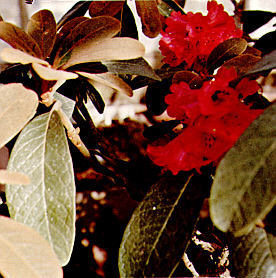QBARS - v30n3 R. mallotum
R. mallotum
Douglas W. Johnson, Issaquah, Washington

|
|
R. mallotum
Photo by Douglas W. Johnson |
R. mallotum is in that elite class of extraordinary rhododendrons, including tsariense and bureavii , whose foliage is of unsurpassed beauty. Being the largest member of the Neriiflorum Series, R. mallotum is capable of reaching 20 feet in height. Its rate of growth has been recorded at 8 feet in 15 years under favorable conditions.
The foliage cannot be adequately described nor justly photographed; it must be seen and touched and dreamed about and remembered when encountering all other rhododendrons. The leaves are rich. They beg to be touched and examined. Here is indumentum at its best: thick, woolly and bright orange-brown. A close look at this fascinating characteristic reveals two strata of hairs; an upper stratum of large, narrow, ribbon-like dendroid hairs over a lower stratum of rosulate hairs. The upper surface of the young leaves is heavily dusted with buff-colored tomentum which eventually is shed revealing a deep, bottle-green, heavily-veined surface. The petioles and branchlets are clothed in tomentum also. Mature leaves reach 9 inches in length and 3 or more inches in width. During normal years in the Seattle area, R. mallotum flowers during the second half of March. Its crimson flowers arrive in trusses of up to 15 and are similar to its nearest relative in the Haematodes Subseries, R. beanianum . George Forrest found it twice, once during his 1917-19 expedition (No. 17853) and later during his 1924-25 collecting (No. 25067). Farrer collected it in Upper Burma during 1919 (No. 815).
R. mallotum does best when planted in partial shade and given good drainage combined with plenty of moisture. Although the ARS has assigned to it a hardiness rating of H-4, Seattle area specimens are usually provided with protection befitting a rating of H-5. As with other members of the Neriiflorum Series, one ought not to fertilize this species; rather, plant it properly to start with and then follow with a yearly mulch liberally applied. A fine specimen at Logan, Wigtownshire, Scotland is pictured in the 1965 RHS Yearbook, figure 3.
